Sentinel Data for Monitoring of Pollutant Emissions by Maritime Transport—A Literature Review
Abstract
1. Introduction
2. Materials and Methods
2.1. PRISMA
2.2. VOSviewer
3. Results and Discussion
3.1. Sentinel-1
3.2. Sentinel-2
3.3. Sentinel-5P
3.3.1. Nitrogen Dioxide ()
3.3.2. Sulphur Dioxide ()
3.3.3. Ozone ()
3.3.4. Aerosols
3.3.5. Methane ()
3.3.6. Broader Studies and Perspectives
3.4. Shipping Contribution
3.5. Effect of COVID-19
3.6. Limitations and Future Directions
4. Conclusions
Funding
Data Availability Statement
Acknowledgments
Conflicts of Interest
References
- Le Traon, P.Y.; Reppucci, A.; Alvarez Fanjul, E.; Aouf, L.; Behrens, A.; Belmonte, M.; Bentamy, A.; Bertino, L.; Brando, V.E.; Kreiner, M.B.; et al. From Observation to Information and Users: The Copernicus Marine Service Perspective. Front. Mar. Sci. 2019, 6, 234. [Google Scholar] [CrossRef]
- Aschbacher, J.; Milagro-Pérez, M.P. The European Earth monitoring (GMES) programme: Status and perspectives. Remote Sens. Environ. 2012, 120, 3–8. [Google Scholar] [CrossRef]
- Saliba, M.; Azzopardi, F.; Muscat, R.; Grima, M.; Smyth, A.; Jalkanen, J.P.; Johansson, L.; Deidun, A.; Gauci, A.; Galdies, C.; et al. Trends in Vessel Atmospheric Emissions in the Central Mediterranean over the Last 10 Years and during the COVID-19 Outbreak. J. Mar. Sci. Eng. 2021, 9, 762. [Google Scholar] [CrossRef]
- Copernicus Sentinel-5P, TROPOMI Level 2 Nitrogen Dioxide Total Column Products, Version 01; European Space Agency (ESA): Paris, France, 2018. [CrossRef]
- Copernicus Sentinel-5P, TROPOMI Level 2 Nitrogen Dioxide Total Column Products, Version 02; European Space Agency (ESA): Paris, France, 2021. [CrossRef]
- Grover, A.; Kumar, S.; Kumar, A. Ship Detection Using Sentinel-1 Sar Data. Isprs Ann. Photogramm. Remote Sens. Spat. Inf. Sci. 2018, 4, 317–324. [Google Scholar] [CrossRef]
- Santamaria, C.; Alvarez, M.; Greidanus, H.; Syrris, V.; Soille, P.; Argentieri, P. Mass Processing of Sentinel-1 Images for Maritime Surveillance. Remote Sens. 2017, 9, 678. [Google Scholar] [CrossRef]
- Kurchaba, S.; van Vliet, J.; Verbeek, F.J.; Veenman, C.J. Anomalous NO2 emitting ship detection with TROPOMI satellite data and machine learning. Remote Sens. Environ. 2023, 297, 113761. [Google Scholar] [CrossRef]
- Rodriguez Valido, M.; Perez Marrero, J.; Mauro González, A.; Fabiani Bendicho, P.; Efrem Mora, C. Evaluation of the Potential of Sentinel-5P TROPOMI and AIS Marine Traffic Data for the Monitoring of Anthropogenic Activity and Maritime Transport NOx-Emissions in Canary Islands Waters. Sustainability 2023, 15, 4632. [Google Scholar] [CrossRef]
- Ziemke, J.R.; Olsen, M.A.; Witte, J.C.; Douglass, A.R.; Strahan, S.E.; Wargan, K.; Liu, X.; Schoeberl, M.R.; Yang, K.; Kaplan, T.B.; et al. Assessment and applications of NASA ozone data products derived from Aura OMI/MLS satellite measurements in context of the GMI chemical transport model. J. Geophys. Res. Atmos. 2014, 119, 5671–5699. [Google Scholar] [CrossRef]
- García, O.E.; Sepúlveda, E.; Schneider, M.; Hase, F.; August, T.; Blumenstock, T.; Kühl, S.; Munro, R.; Gómez-Peláez, A.J.; Hultberg, T.; et al. Consistency and quality assessment of the Metop-A/IASI and Metop-B/IASI operational trace gas products (O3, CO, N2O, CH4, and CO2) in the subtropical North Atlantic. Atmos. Meas. Tech. 2016, 9, 2315–2333. [Google Scholar] [CrossRef]
- Kramarova, N.A.; Xu, P.; Mok, J.; Bhartia, P.K.; Jaross, G.; Moy, L.; Chen, Z.; Frith, S.; DeLand, M.; Kahn, D.; et al. Decade-Long Ozone Profile Record From Suomi NPP OMPS Limb Profiler: Assessment of Version 2.6 Data. Earth Space Sci. 2024, 11, e2024EA003707. [Google Scholar] [CrossRef]
- Piters, A.J.M.; Bramstedt, K.; Lambert, J.C.; Kirchhoff, B. Overview of SCIAMACHY validation: 2002–2004. Atmos. Chem. Phys. 2006, 6, 127–148. [Google Scholar] [CrossRef]
- Parker, R.J.; Webb, A.; Boesch, H.; Somkuti, P.; Barrio Guillo, R.; Di Noia, A.; Kalaitzi, N.; Anand, J.S.; Bergamaschi, P.; Chevallier, F.; et al. A decade of GOSAT Proxy satellite CH4 observations. Earth Syst. Sci. Data 2020, 12, 3383–3412. [Google Scholar] [CrossRef]
- Acker, S.J.; Holloway, T.; Harkey, M.K. Satellite Detection of NO2 Distributions and Comparison with Ground-Based Concentrations. EGUsphere 2025, 2025, 1–39. [Google Scholar] [CrossRef]
- Choi, H.; Liu, X.; Jeong, U.; Chong, H.; Kim, J.; Ahn, M.H.; Ko, D.H.; Lee, D.W.; Moon, K.J.; Lee, K.M. Geostationary Environment Monitoring Spectrometer (GEMS) polarization characteristics and correction algorithm. Atmos. Meas. Tech. 2024, 17, 145–164. [Google Scholar] [CrossRef]
- Lee, H.J.; Kim, N.R.; Shin, M.Y. Capabilities of satellite Geostationary Environment Monitoring Spectrometer (GEMS) NO2 data for hourly ambient NO2 exposure modeling. Environ. Res. 2024, 261, 119633. [Google Scholar] [CrossRef]
- Secretariat, U. United Nations Conference on Trade and Development (UNCTAD) Review of Maritime Transport 2002. Available online: https://unctad.org/publication/review-maritime-transport-2023 (accessed on 27 September 2023).
- Hasan, M. Analyzing the Blue Economy Potential of Pakistan’s Maritime Sector. Qlantic J. Soc. Sci. Humanit. 2024, 5, 202–209. [Google Scholar] [CrossRef]
- Georgoulias, A.K.; Boersma, K.F.; van Vliet, J.; Zhang, X.; van der A, R.; Zanis, P.; de Laat, J. Detection of NO2 pollution plumes from individual ships with the TROPOMI/S5P satellite sensor. Environ. Res. Lett. 2020, 15, 124037. [Google Scholar] [CrossRef]
- Bodansky, D. Chapter.17 Regulating Greenhouse Gas Emissions from Ships: The Role of the International Maritime Organization; Brill|Nijhoff: Leiden, The Netherlands, 2018; pp. 478–501. [Google Scholar] [CrossRef]
- Monteiro, A.; Russo, M.; Gama, C.; Borrego, C. Impact of SO2 shipping emissions on air quality: The airship project. WIT Trans. Ecol. Environ. 2018, 230, 429–437. [Google Scholar]
- Viana, M.; Hammingh, P.; Colette, A.; Querol, X.; Degraeuwe, B.; de Vlieger, I.; van Aardenne, J. Impact of maritime transport emissions on coastal air quality in Europe. Atmos. Environ. 2014, 90, 96–105. [Google Scholar] [CrossRef]
- Wang, H.; Liu, D.; Dai, G. Review of maritime transportation air emission pollution and policy analysis. J. Ocean Univ. China 2009, 8, 283–290. [Google Scholar] [CrossRef]
- Mahía Prados, J.M.; Arias Fernández, I.; Romero Gómez, M.; Naveiro Parga, M. The decarbonisation of the maritime sector: Horizon 2050. Brodogr. Int. J. Nav. Archit. Ocean. Eng. Res. Dev. 2024, 75, 1–26. [Google Scholar]
- Sorte, S.; Rodrigues, V.; Borrego, C.; Monteiro, A. Impact of harbour activities on local air quality: A review. Environ. Pollut. 2020, 257, 113542. [Google Scholar] [CrossRef] [PubMed]
- Monteiro, A.; Sá, E.; Fernandes, A.; Gama, C.; Sorte, S.; Borrego, C.; Lopes, M. Air quality over Portugal: Now and in 2050. WIT Trans. Ecol. Environ. 2017, 210, 621–630. [Google Scholar]
- Batista, T.; Rosa, L.; Borges, F.A.; Isbaex, C.; Martins, S. Shipping Patterns at the Port of Sines: A Temporal Analysis from 2010 to 2023. Sustainability 2025, 17, 2344. [Google Scholar] [CrossRef]
- Isbaex, C.; Costa, F.d.R.F.; Batista, T. Application of GIS in the Maritime-Port Sector: A Systematic Review. Sustainability 2025, 17, 3386. [Google Scholar] [CrossRef]
- Gordin, M.D. Scientific Babel: How Science Was Done Before and After Global English; University of Chicago Press: Chicago, IL, USA, 2015. [Google Scholar]
- Morales-Alarcón, C.H.; Bodero-Poveda, E.; Villa-Yánez, H.M.; Buñay-Guisñan, P.A. Blockchain and Its Application in the Peer Review of Scientific Works: A Systematic Review. Publications 2024, 12, 40. [Google Scholar] [CrossRef]
- Wong, D. VOSviewer. Tech. Serv. Q. 2018, 35, 219–220. [Google Scholar] [CrossRef]
- Corporation for Digital Scholarship and Roy Rosenzweig Center for History and New Media. Zotero: Your Personal Research Assistant 2024. Available online: https://www.zotero.org/ (accessed on 17 June 2025).
- Page, M.J.; McKenzie, J.E.; Bossuyt, P.M.; Boutron, I.; Hoffmann, T.C.; Mulrow, C.D.; Shamseer, L.; Tetzlaff, J.M.; Akl, E.A.; Brennan, S.E.; et al. The PRISMA 2020 statement: An updated guideline for reporting systematic reviews. BMJ 2021, 372, n71. [Google Scholar] [CrossRef]
- Christiani, P.; Rana, P.; Räsänen, A.; Pitkänen, T.P.; Tolvanen, A. Detecting Spatial Patterns of Peatland Greenhouse Gas Sinks and Sources with Geospatial Environmental and Remote Sensing Data. Environ. Manag. 2024, 74, 461–478. [Google Scholar] [CrossRef]
- Sjögersten, S.; Ledger, M.; Siewert, M.; de la Barreda-Bautista, B.; Sowter, A.; Gee, D.; Foody, G.; Boyd, D.S. Optical and radar Earth observation data for upscaling methane emissions linked to permafrost degradation in sub-Arctic peatlands in northern Sweden. Biogeosciences 2023, 20, 4221–4239. [Google Scholar] [CrossRef]
- Pointner, G.; Bartsch, A.; Dvornikov, Y.A.; Kouraev, A.V. Mapping potential signs of gas emissions in ice of Lake Neyto, Yamal, Russia, using synthetic aperture radar and multispectral remote sensing data. Cryosphere 2021, 15, 1907–1929. [Google Scholar] [CrossRef]
- Lohberger, S.; Stängel, M.; Atwood, E.C.; Siegert, F. Spatial evaluation of Indonesia’s 2015 fire-affected area and estimated carbon emissions using Sentinel-1. Glob. Change Biol. 2018, 24, 644–654. [Google Scholar] [CrossRef] [PubMed]
- Tuy, S.; Lee, H.S.; Chreng, K. Integrated assessment of offshore wind power potential using Weather Research and Forecast (WRF) downscaling with Sentinel-1 satellite imagery, optimal sites, annual energy production and equivalent CO2 reduction. Renew. Sustain. Energy Rev. 2022, 163, 112501. [Google Scholar] [CrossRef]
- Xu, Z.; Zhang, H.; Wang, Y.; Wang, X.; Xue, S.; Liu, W. Dynamic detection of offshore wind turbines by spatial machine learning from spaceborne synthetic aperture radar imagery. J. King Saud Univ. Comput. Inf. Sci. 2022, 34, 1674–1686. [Google Scholar] [CrossRef]
- Wang, H.; Fan, X.; Jian, H.; Yan, F. Exploiting the Matched Filter to Improve the Detection of Methane Plumes with Sentinel-2 Data. Remote Sens. 2024, 16, 1023. [Google Scholar] [CrossRef]
- Varon, D.J.; Jervis, D.; Pandey, S.; Gallardo, S.L.; Balasus, N.; Yang, L.H.; Jacob, D.J. Quantifying NO(x) point sources with Landsat and Sentinel-2 satellite observations of NO(2) plumes. Proc. Natl. Acad. Sci. USA 2024, 121, e2317077121. [Google Scholar] [CrossRef]
- Bilgiç, E.; Tuna Tuygun, G.; Gündüz, O. Development of an emission estimation method with satellite observations for significant forest fires and comparison with global fire emission inventories: Application to catastrophic fires of summer 2021 over the Eastern Mediterranean. Atmos. Environ. 2023, 308, 119871. [Google Scholar] [CrossRef]
- Mamić, L.; Gašparović, M.; Kaplan, G. Developing PM2.5 and PM10 prediction models on a national and regional scale using open-source remote sensing data. Environ. Monit. Assess. 2023, 195, 644. [Google Scholar] [CrossRef]
- Yang, Q.; Yuan, Q.; Li, T. Ultrahigh-resolution PM2.5 estimation from top-of-atmosphere reflectance with machine learning: Theories, methods, and applications. Environ. Pollut. 2022, 306, 119347. [Google Scholar] [CrossRef]
- Tabunschik, V.; Gorbunov, R.; Bratanov, N.; Gorbunova, T.; Mirzoeva, N.; Voytsekhovskaya, V. Fatala River Basin (Republic of Guinea, Africa): Analysis of Current State, Air Pollution, and Anthropogenic Impact Using Geoinformatics Methods and Remote Sensing Data. Sustainability 2023, 15, 15798. [Google Scholar] [CrossRef]
- Ricaud, P.; Attié, J.L.; Chalinel, R.; Pasternak, F.; Léonard, J.; Pison, I.; Pattey, E.; Thompson, R.L.; Zelinger, Z.; Lelieveld, J.; et al. The Monitoring Nitrous Oxide Sources (MIN2OS) satellite project. Remote Sens. Environ. 2021, 266, 112688. [Google Scholar] [CrossRef]
- Pseftogkas, A.; Koukouli, M.E.; Manders, A.; Segers, A.; Stavrakou, T.; Tokaya, J.; Meleti, C.; Balis, D. Maritime sector contributions on NO2 surface concentrations in major ports of the Mediterranean Basin. Atmos. Pollut. Res. 2024, 15, 102228. [Google Scholar] [CrossRef]
- Kurchaba, S.; Sokolovsky, A.; van Vliet, J.; Verbeek, F.J.; Veenman, C.J. Sensitivity analysis for the detection of NO2 plumes from seagoing ships using TROPOMI data. Remote Sens. Environ. 2024, 304, 114041. [Google Scholar] [CrossRef]
- Abdullah, M.A.; Chuah, L.; Abdullah, S.B.; Bokhari, A.; Syed, A.; Elgorban, A.M.; Akhtar, M.S.; AL-Shwaiman, H.A.; Asif, S. From port to planet: Assessing NO2 pollution and climate change effects with Sentinel-5p satellite imagery in maritime zones. Environ. Res. 2024, 257, 119328. [Google Scholar] [CrossRef]
- Soleimany, A.; Grubliauskas, R.; Šerevičienė, V. Application of satellite data and GIS services for studying air pollutants in Lithuania (case study: Kaunas city). Air Qual. Atmos. Health 2021, 14, 411–429. [Google Scholar] [CrossRef]
- Adame, J.; Gutierrez-Alvarez, I.; Bolivar, J.; Yela, M. Ground-based and OMI-TROPOMI NO2 measurements at El Arenosillo observatory: Unexpected upward trends. Environ. Pollut. 2020, 264, 114771. [Google Scholar] [CrossRef]
- Leifer, I.; Melton, C.; Blake, D.R.; Meinardi, S.; Kleinman, M. Air quality trends for the ports of Los Angeles and Long Beach spanning the covid19 crisis: Part 1. Oxidant pollutants. Atmos. Environ. 2023, 312, 119949. [Google Scholar] [CrossRef]
- Wang, K.; Wu, K.; Wang, C.; Tong, Y.; Gao, J.; Zuo, P.; Zhang, X.; Yue, T. Identification of NOx hotspots from oversampled TROPOMI NO2 column based on image segmentation method. Sci. Total Environ. 2022, 803, 150007. [Google Scholar] [CrossRef]
- Tzortziou, M.; Loughner, C.P.; Goldberg, D.L.; Judd, L.; Nauth, D.; Kwong, C.F.; Lin, T.; Cede, A.; Abuhassan, N. Intimately tracking NO2 pollution over the New York City—Long Island Sound land-water continuum: An integration of shipboard, airborne, satellite observations, and models. Sci. Total Environ. 2023, 897, 165144. [Google Scholar] [CrossRef]
- Wang, X.; Zhang, C.; Gao, Y.; Ji, X.; Su, W.; Liu, C. Satellite unravels recent changes in atmospheric nitrogen oxides emissions from global ocean shipping. J. Clean. Prod. 2023, 429, 139591. [Google Scholar] [CrossRef]
- Petetin, H.; Guevara, M.; Compernolle, S.; Bowdalo, D.; Bretonnière, P.A.; Enciso, S.; Jorba, O.; Lopez, F.; Soret, A.; Pérez García-Pando, C. Potential of TROPOMI for understanding spatio-temporal variations in surface NO2 and their dependencies upon land use over the Iberian Peninsula. Atmos. Chem. Phys. 2023, 23, 3905–3935. [Google Scholar] [CrossRef]
- Riess, T.C.V.W.; Boersma, K.F.; van Vliet, J.; Peters, W.; Sneep, M.; Eskes, H.; van Geffen, J. Improved monitoring of shipping NO2 with TROPOMI: Decreasing NOx emissions in European seas during the COVID-19 pandemic. Atmos. Meas. Tech. 2022, 15, 1415–1438. [Google Scholar] [CrossRef]
- Kurchaba, S.; van Vliet, J.; Verbeek, F.J.; Meulman, J.J.; Veenman, C.J. Supervised Segmentation of NO2 Plumes from Individual Ships Using TROPOMI Satellite Data. Remote Sens. 2022, 14, 5809. [Google Scholar] [CrossRef]
- Pseftogkas, A.; Koukouli, M.E.; Skoulidou, I.; Balis, D.; Meleti, C.; Stavrakou, T.; Falco, L.; van Geffen, J.; Eskes, H.; Segers, A.; et al. A New Separation Methodology for the Maritime Sector Emissions over the Mediterranean and Black Sea Regions. Atmosphere 2021, 12, 1478. [Google Scholar] [CrossRef]
- van der A, R.J.; Ding, J.; Eskes, H. Monitoring European anthropogenic NOx emissions from space. Atmos. Chem. Phys. 2024, 24, 7523–7534. [Google Scholar] [CrossRef]
- Kim, J.; Emmerich, M.T.M.; Voors, R.; Ording, B.; Lee, J.S. A Systematic Approach to Identify Shipping Emissions Using Spatio-Temporally Resolved TROPOMI Data. Remote Sens. 2023, 15, 3453. [Google Scholar] [CrossRef]
- Goldberg, D.L.; Anenberg, S.C.; Kerr, G.H.; Mohegh, A.; Lu, Z.; Streets, D.G. TROPOMI NO2 in the United States: A Detailed Look at the Annual Averages, Weekly Cycles, Effects of Temperature, and Correlation With Surface NO2 Concentrations. Earth’s Future 2021, 9, e2020EF001665. [Google Scholar] [CrossRef]
- Riess, T.C.V.W.; Boersma, K.F.; Van Roy, W.; de Laat, J.; Dammers, E.; van Vliet, J. To new heights by flying low: Comparison of aircraft vertical NO2 profiles to model simulations and implications for TROPOMI NO2 retrievals. Atmos. Meas. Tech. 2023, 16, 5287–5304. [Google Scholar] [CrossRef]
- Thompson, A.M.; Kollonige, D.E.; Stauffer, R.M.; Kotsakis, A.E.; Abuhassan, N.; Lamsal, L.N.; Swap, R.J.; Blake, D.R.; Townsend-Small, A.; Wecht, H.D. Two Air Quality Regimes in Total Column NO2 Over the Gulf of Mexico in May 2019: Shipboard and Satellite Views. Earth Space Sci. 2023, 10, e2022EA002473. [Google Scholar] [CrossRef]
- Douros, J.; Eskes, H.; van Geffen, J.; Boersma, K.F.; Compernolle, S.; Pinardi, G.; Blechschmidt, A.M.; Peuch, V.H.; Colette, A.; Veefkind, P. Comparing Sentinel-5P TROPOMI NO2 column observations with the CAMS regional air quality ensemble. Geosci. Model Dev. 2023, 16, 509–534. [Google Scholar] [CrossRef]
- Alberti, C.; Tu, Q.; Hase, F.; Makarova, M.V.; Gribanov, K.; Foka, S.C.; Zakharov, V.; Blumenstock, T.; Buchwitz, M.; Diekmann, C.; et al. Investigation of spaceborne trace gas products over St Petersburg and Yekaterinburg, Russia, by using COllaborative Column Carbon Observing Network (COCCON) observations. Atmos. Meas. Tech. 2022, 15, 2199–2229. [Google Scholar] [CrossRef]
- Farahat, A.; El-Kork, N.; Singh, R.P.; Jing, F. Possible Overestimation of Nitrogen Dioxide Outgassing during the Beirut 2020 Explosion. Remote Sens. 2022, 14, 6377. [Google Scholar] [CrossRef]
- Mejía C., D.; Alvarez, H.; Zalakeviciute, R.; Macancela, D.; Sanchez, C.; Bonilla, S. Sentinel satellite data monitoring of air pollutants with interpolation methods in Guayaquil, Ecuador. Remote Sens. Appl. Soc. Environ. 2023, 31, 100990. [Google Scholar] [CrossRef]
- Xue, R.; Wang, S.; Zhang, S.; He, S.; Liu, J.; Tanvir, A.; Zhou, B. Estimating city NOx emissions from TROPOMI high spatial resolution observations—A case study on Yangtze River Delta, China. Urban Clim. 2022, 43, 101150. [Google Scholar] [CrossRef]
- Wang, Y.; Xu, G.; Chen, L.; Chen, K. Characteristics of Air Pollutant Distribution and Sources in the East China Sea and the Yellow Sea in Spring Based on Multiple Observation Methods. Remote Sens. 2023, 15, 3262. [Google Scholar] [CrossRef]
- Lonsdale, C.R.; Sun, K. Nitrogen oxides emissions from selected cities in North America, Europe, and East Asia observed by the TROPOspheric Monitoring Instrument (TROPOMI) before and after the COVID-19 pandemic. Atmos. Chem. Phys. 2023, 23, 8727–8748. [Google Scholar] [CrossRef]
- Souri, A.H.; Chance, K.; Bak, J.; Nowlan, C.R.; González Abad, G.; Jung, Y.; Wong, D.C.; Mao, J.; Liu, X. Unraveling pathways of elevated ozone induced by the 2020 lockdown in Europe by an observationally constrained regional model using TROPOMI. Atmos. Chem. Phys. 2021, 21, 18227–18245. [Google Scholar] [CrossRef]
- Liu, S.; Li, X.; Li, J.; Shu, L.; Fu, T.M.; Yang, X.; Zhu, L. Observing network effect of shipping emissions from space: A natural experiment in the world’s busiest port. PNAS Nexus 2023, 2, pgad391. [Google Scholar] [CrossRef]
- Solberg, S.; Walker, S.E.; Schneider, P.; Guerreiro, C. Quantifying the Impact of the Covid-19 Lockdown Measures on Nitrogen Dioxide Levels throughout Europe. Atmosphere 2021, 12, 131. [Google Scholar] [CrossRef]
- Skipper, T.N.; Kaiser, J.; Odman, M.T.; Hasheminassab, S.; Russell, A.G. Local scale air quality impacts in the Los Angeles Basin from increased port activity during 2021 supply chain disruptions. Environ. Sci. Atmos. 2024, 4, 321–329. [Google Scholar] [CrossRef]
- Filonchyk, M.; Yan, H.; Hurynovich, V.; Wang, Z. Impact of COVID-19 pandemic on air quality changes in Shanghai, China. Environ. Forensics 2022, 23, 1–6. [Google Scholar] [CrossRef]
- Potts, D.A.; Marais, E.A.; Boesch, H.; Pope, R.J.; Lee, J.; Drysdale, W.; Chipperfield, M.P.; Kerridge, B.; Siddans, R.; Moore, D.P.; et al. Diagnosing air quality changes in the UK during the COVID-19 lockdown using TROPOMI and GEOS-Chem. Environ. Res. Lett. 2021, 16, 054031. [Google Scholar] [CrossRef]
- Silva, A.C.T.; Branco, P.T.B.S.; Ferrini Rodrigues, P.; Sousa, S.I.V. Sustainable policies for air pollution reduction after COVID-19 pandemic: Lessons learnt from the impact of the different lockdown periods on air quality. Sustain. Dev. 2023, 31, 959–975. [Google Scholar] [CrossRef]
- Nurhisanah, S.; Hasyim, H. Environmental health risk assessment of sulfur dioxide (SO2) at workers around in combined cycle power plant (CCPP). Heliyon 2022, 8, e09388. [Google Scholar] [CrossRef]
- Schmidt, S.; Kinne, J.; Lautenbach, S.; Blaschke, T.; Lenz, D.; Resch, B. Greenwashing in the US metal industry? A novel approach combining SO2 concentrations from satellite data, a plant-level firm database and web text mining. Sci. Total Environ. 2022, 835, 155512. [Google Scholar] [CrossRef]
- Sullivan, J.T.; Berkoff, T.; Gronoff, G.; Knepp, T.; Pippin, M.; Allen, D.; Twigg, L.; Swap, R.; Tzortziou, M.; Thompson, A.M.; et al. The Ozone Water–Land Environmental Transition Study: An Innovative Strategy for Understanding Chesapeake Bay Pollution Events. Bull. Am. Meteorol. Soc. 2019, 100, 291–306. [Google Scholar] [CrossRef]
- Wu, S.; Lee, H.J.; Anderson, A.; Liu, S.; Kuwayama, T.; Seinfeld, J.H.; Kleeman, M.J. Direct measurements of ozone response to emissions perturbations in California. Atmos. Chem. Phys. 2022, 22, 4929–4949. [Google Scholar] [CrossRef]
- Goldberg, D.L.; Harkey, M.; de Foy, B.; Judd, L.; Johnson, J.; Yarwood, G.; Holloway, T. Evaluating NOx emissions and their effect on O3 production in Texas using TROPOMI NO2 and HCHO. Atmos. Chem. Phys. 2022, 22, 10875–10900. [Google Scholar] [CrossRef]
- Balamurugan, V.; Chen, J.; Wenzel, A.; Keutsch, F.N. Spatiotemporal modeling of air pollutant concentrations in Germany using machine learning. Atmos. Chem. Phys. 2023, 23, 10267–10285. [Google Scholar] [CrossRef]
- Filonchyk, M.; Peterson, M.P. Changes in aerosol properties at the El Arenosillo site in Southern Europe as a result of the 2023 Canadian forest fires. Environ. Res. 2024, 260, 119629. [Google Scholar] [CrossRef]
- Zhang, S.; Ma, J.; Zhang, X.; Guo, C. Atmospheric remote sensing for anthropogenic methane emissions: Applications and research opportunities. Sci. Total Environ. 2023, 893, 164701. [Google Scholar] [CrossRef] [PubMed]
- Tu, Q.; Hase, F.; Schneider, M.; García, O.; Blumenstock, T.; Borsdorff, T.; Frey, M.; Khosrawi, F.; Lorente, A.; Alberti, C.; et al. Quantification of CH4 emissions from waste disposal sites near the city of Madrid using ground- and space-based observations of COCCON, IASI. Atmos. Chem. Phys. 2022, 22, 295–317. [Google Scholar] [CrossRef]
- Tu, Q.; Hase, F.; Blumenstock, T.; Kivi, R.; Heikkinen, P.; Sha, M.K.; Raffalski, U.; Landgraf, J.; Lorente, A.; Borsdorff, T.; et al. Intercomparison of atmospheric CO2 and CH4 abundances on regional scales in boreal areas using Copernicus Atmosphere Monitoring Service (CAMS) analysis, COllaborative Carbon Column Observing Network (COCCON) spectrometers, and Sentinel-5 Precursor satellite observations. Atmos. Meas. Tech. 2020, 13, 4751–4771. [Google Scholar] [CrossRef]
- Zhang, J.; Han, G.; Mao, H.; Pei, Z.; Ma, X.; Jia, W.; Gong, W. The Spatial and Temporal Distribution Patterns of XCH4 in China: New Observations from TROPOMI. Atmosphere 2022, 13, 177. [Google Scholar] [CrossRef]
- Magro, C.; Nunes, L.; Gonçalves, O.C.; Neng, N.R.; Nogueira, J.M.F.; Rego, F.C.; Vieira, P. Atmospheric Trends of CO and CH4 from Extreme Wildfires in Portugal Using Sentinel-5P TROPOMI Level-2 Data. Fire 2021, 4, 25. [Google Scholar] [CrossRef]
- Moon, J.; Shim, C.; Seo, J.; Han, J. Evaluation of Korean methane emission sources with satellite retrievals by spatial correlation analysis. Environ. Monit. Assess. 2024, 196, 296. [Google Scholar] [CrossRef]
- Schuit, B.J.; Maasakkers, J.D.; Bijl, P.; Mahapatra, G.; van den Berg, A.W.; Pandey, S.; Lorente, A.; Borsdorff, T.; Houweling, S.; Varon, D.J.; et al. Automated detection and monitoring of methane super-emitters using satellite data. Atmos. Chem. Phys. 2023, 23, 9071–9098. [Google Scholar] [CrossRef]
- Knapp, M.; Kleinschek, R.; Hase, F.; Agustí-Panareda, A.; Inness, A.; Barré, J.; Landgraf, J.; Borsdorff, T.; Kinne, S.; Butz, A. Shipborne measurements of XCO2, XCH4, and XCO above the Pacific Ocean and comparison to CAMS atmospheric analyses and S5P/TROPOMI. Earth Syst. Sci. Data 2021, 13, 199–211. [Google Scholar] [CrossRef]
- Mahmud, K.; Mitra, B.; Uddin, M.S.; Hridoy, A.E.E.; Aina, Y.A.; Abubakar, I.R.; Rahman, S.M.; Tan, M.L.; Rahman, M.M. Temporal assessment of air quality in major cities in Nigeria using satellite data. Atmos. Environ. X 2023, 20, 100227. [Google Scholar] [CrossRef]
- Palmer, P.I.; O’Doherty, S.; Allen, G.; Bower, K.; Bösch, H.; Chipperfield, M.P.; Connors, S.; Dhomse, S.; Feng, L.; Finch, D.P.; et al. A measurement-based verification framework for UK greenhouse gas emissions: An overview of the Greenhouse gAs Uk and Global Emissions (GAUGE) project. Atmos. Chem. Phys. 2018, 18, 11753–11777. [Google Scholar] [CrossRef]
- Li, S.; Kenea, S.T.; Kim, S.; Yoo, H.J.; Joo, S.; Lee, H.; Oh, S.; Jeong, M.J.; Seo, W.; Ko, M.; et al. Latitudinal distribution and sources analysis of greenhouse gases and air pollutants observed during the 2021 Yellow Sea Air Quality campaign aboard a research vessel. Atmos. Environ. 2024, 317, 120201. [Google Scholar] [CrossRef]
- Mitra, B.; Hridoy, A.E.E.; Mahmud, K.; Uddin, M.S.; Talha, A.; Das, N.; Nath, S.K.; Shafiullah, M.; Rahman, S.M.; Rahman, M.M. Exploring Spatial and Temporal Dynamics of Red Sea Air Quality through Multivariate Analysis, Trajectories, and Satellite Observations. Remote Sens. 2024, 16, 381. [Google Scholar] [CrossRef]
- Reshi, A.R.; Pichuka, S.; Tripathi, A. Applications of Sentinel-5P TROPOMI Satellite Sensor: A Review. IEEE Sens. J. 2024, 24, 20312–20321. [Google Scholar] [CrossRef]
- Veefkind, J.; Aben, I.; McMullan, K.; Förster, H.; de Vries, J.; Otter, G.; Claas, J.; Eskes, H.; de Haan, J.; Kleipool, Q.; et al. TROPOMI on the ESA Sentinel-5 Precursor: A GMES mission for global observations of the atmospheric composition for climate, air quality and ozone layer applications. Remote Sens. Environ. 2012, 120, 70–83. [Google Scholar] [CrossRef]
- Russo, M.; Leitão, J.; Gama, C.; Ferreira, J.; Monteiro, A. Shipping emissions over Europe: A state-of-the-art and comparative analysis. Atmos. Environ. 2018, 177, 187–194. [Google Scholar] [CrossRef]
- Hsu, C.H.; Henze, D.K.; Mizzi, A.P.; González Abad, G.; He, J.; Harkins, C.; Naeger, A.R.; Lyu, C.; Liu, X.; Chan Miller, C.; et al. An Observing System Simulation Experiment Analysis of How Well Geostationary Satellite Trace-Gas Observations Constrain NOx Emissions in the US. J. Geophys. Res. Atmos. 2024, 129, e2023JD039323. [Google Scholar] [CrossRef]
- Cheng, L.; Wang, Y.; Yan, H.; Tao, J.; Wang, H.; Lin, J.; Xu, J.; Chen, L. Preliminary Global NO2 Retrieval from EMI-II Onboard GF5B/DQ1 and Comparison to TROPOMI. Remote Sens. 2024, 16, 4087. [Google Scholar] [CrossRef]
- van Geffen, J.; Boersma, K.F.; Eskes, H.; Sneep, M.; ter Linden, M.; Zara, M.; Veefkind, J.P. S5P TROPOMI NO2 slant column retrieval: Method, stability, uncertainties and comparisons with OMI. Atmos. Meas. Tech. 2020, 13, 1315–1335. [Google Scholar] [CrossRef]
- Lange, K.; Richter, A.; Bösch, T.; Zilker, B.; Latsch, M.; Behrens, L.K.; Okafor, C.M.; Bösch, H.; Burrows, J.P.; Merlaud, A.; et al. Validation of GEMS tropospheric NO2 columns and their diurnal variation with ground-based DOAS measurements. Atmos. Meas. Tech. 2024, 17, 6315–6344. [Google Scholar] [CrossRef]
- Goldberg, D.L.; Lamsal, L.N.; Loughner, C.P.; Swartz, W.H.; Lu, Z.; Streets, D.G. A high-resolution and observationally constrained OMI NO2 satellite retrieval. Atmos. Chem. Phys. 2017, 17, 11403–11421. [Google Scholar] [CrossRef]
- Hu, X.M.; Hu, J.; Gao, L.; Cai, C.; Jiang, Y.; Xue, M.; Zhao, T.; Crowell, S.M.R. Multisensor and Multimodel Monitoring and Investigation of a Wintertime Air Pollution Event Ahead of a Cold Front Over Eastern China. J. Geophys. Res. Atmos. 2021, 126, e2020JD033538. [Google Scholar] [CrossRef]
- Ma, Y.; Liu, L.; Liu, X.; Chen, J. An improved downscaled sun-induced chlorophyll fluorescence (DSIF) product of GOME-2 dataset. Eur. J. Remote Sens. 2022, 55, 168–180. [Google Scholar] [CrossRef]
- Jeffery, P.S.; Walker, K.A.; Sioris, C.E.; Boone, C.D.; Degenstein, D.; Manney, G.L.; McElroy, C.T.; Millán, L.; Plummer, D.A.; Ryan, N.J.; et al. Water vapour and ozone in the upper troposphere–lower stratosphere: Global climatologies from three Canadian limb-viewing instruments. Atmos. Chem. Phys. 2022, 22, 14709–14734. [Google Scholar] [CrossRef]
- Dimitropoulou, E.; Hendrick, F.; Pinardi, G.; Friedrich, M.M.; Merlaud, A.; Tack, F.; De Longueville, H.; Fayt, C.; Hermans, C.; Laffineur, Q.; et al. Validation of TROPOMI tropospheric NO2 columns using dual-scan multi-axis differential optical absorption spectroscopy (MAX-DOAS) measurements in Uccle, Brussels. Atmos. Meas. Tech. 2020, 13, 5165–5191. [Google Scholar] [CrossRef]
- Park, H.; Jeong, S.; Sha, M.K.; Lee, J.; Frey, M.M. Comparisons of Greenhouse Gas Observation Satellite Performances Over Seoul Using a Portable Ground-Based Spectrometer. Geophys. Res. Lett. 2024, 51, e2024GL109334. [Google Scholar] [CrossRef]
- Freitas, D.; Gervásio, H. The challenge of benchmarking carbon emissions in maritime ports. Environ. Pollut. 2024, 363, 125170. [Google Scholar] [CrossRef]
- von Schuckmann, K.; Traon, P.Y.L.; Smith, N.; Pascual, A.; Djavidnia, S.; Gattuso, J.P.; Grégoire, M.; Aaboe, S.; Alari, V.; Alexander, B.E.; et al. Copernicus Marine Service Ocean State Report, Issue 5. J. Oper. Oceanogr. 2021, 14, 1–185. [Google Scholar] [CrossRef]
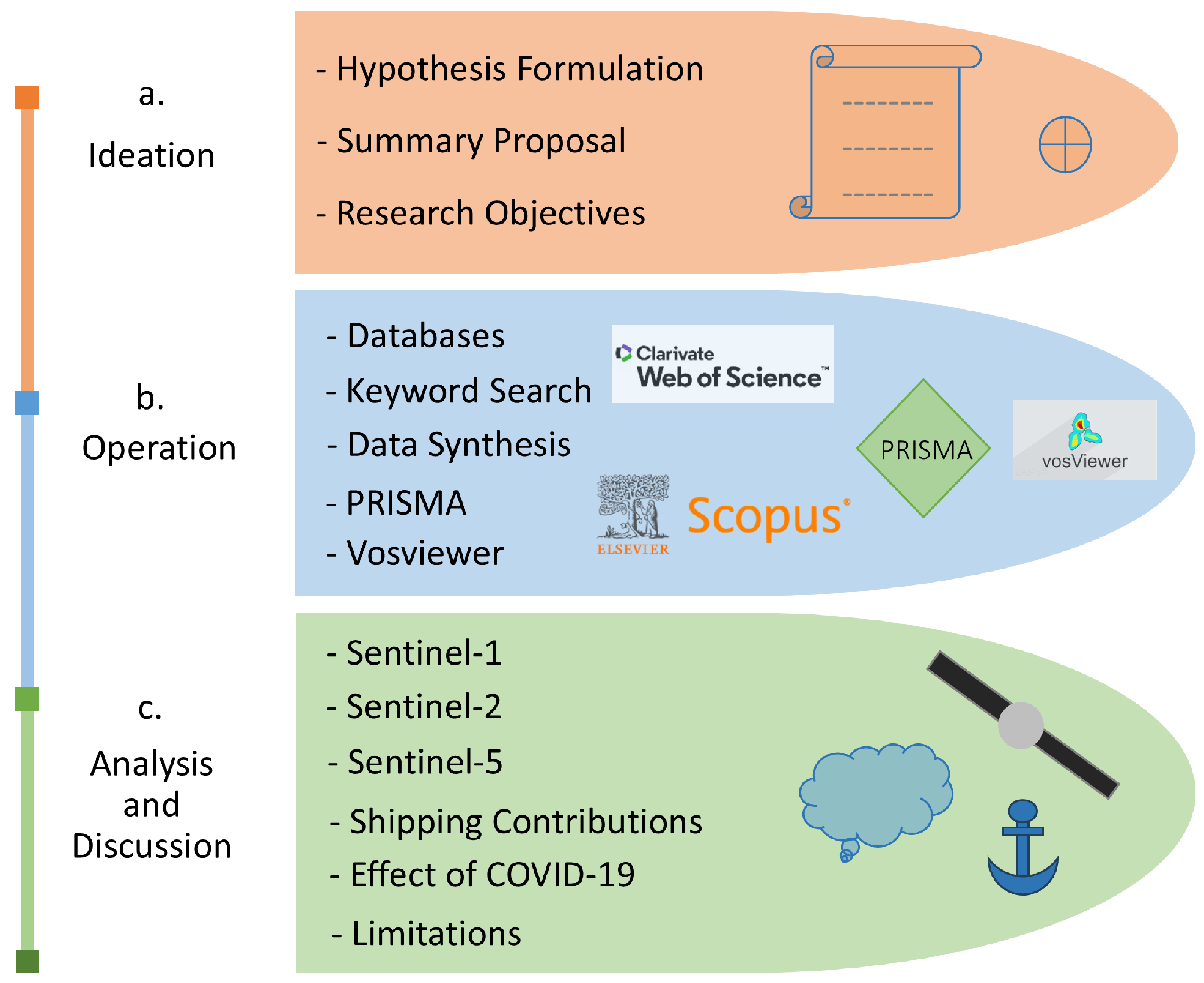
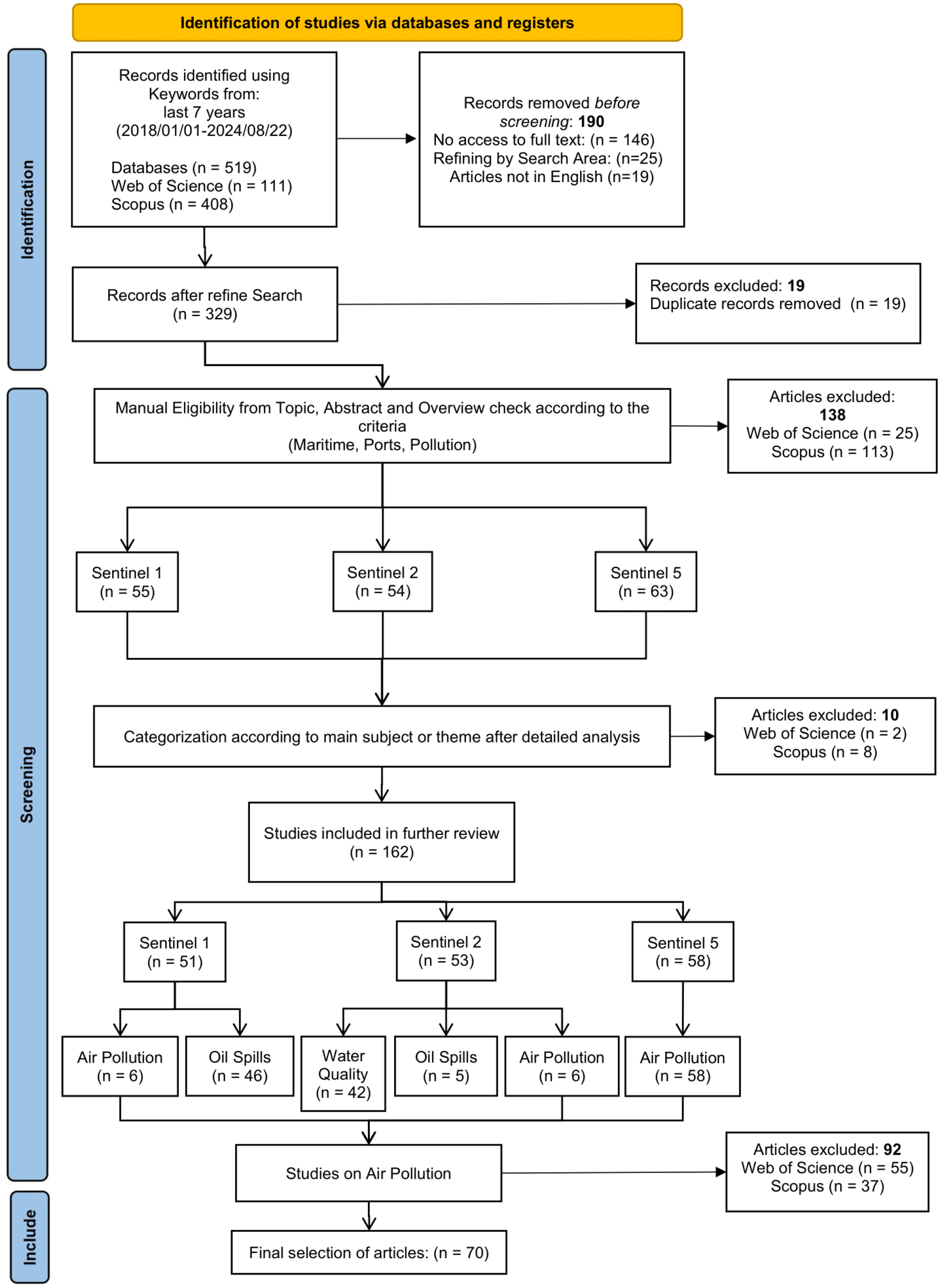
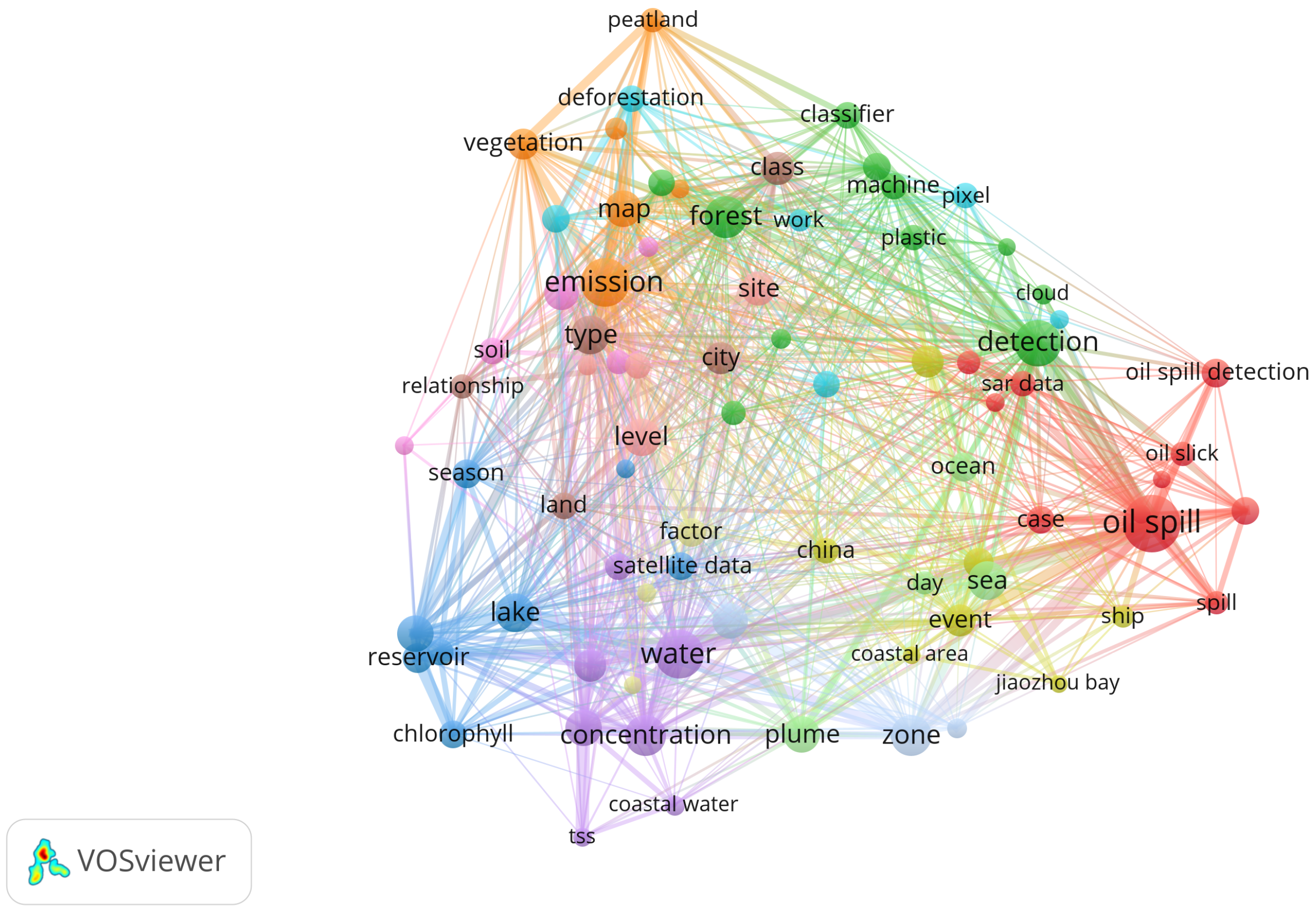
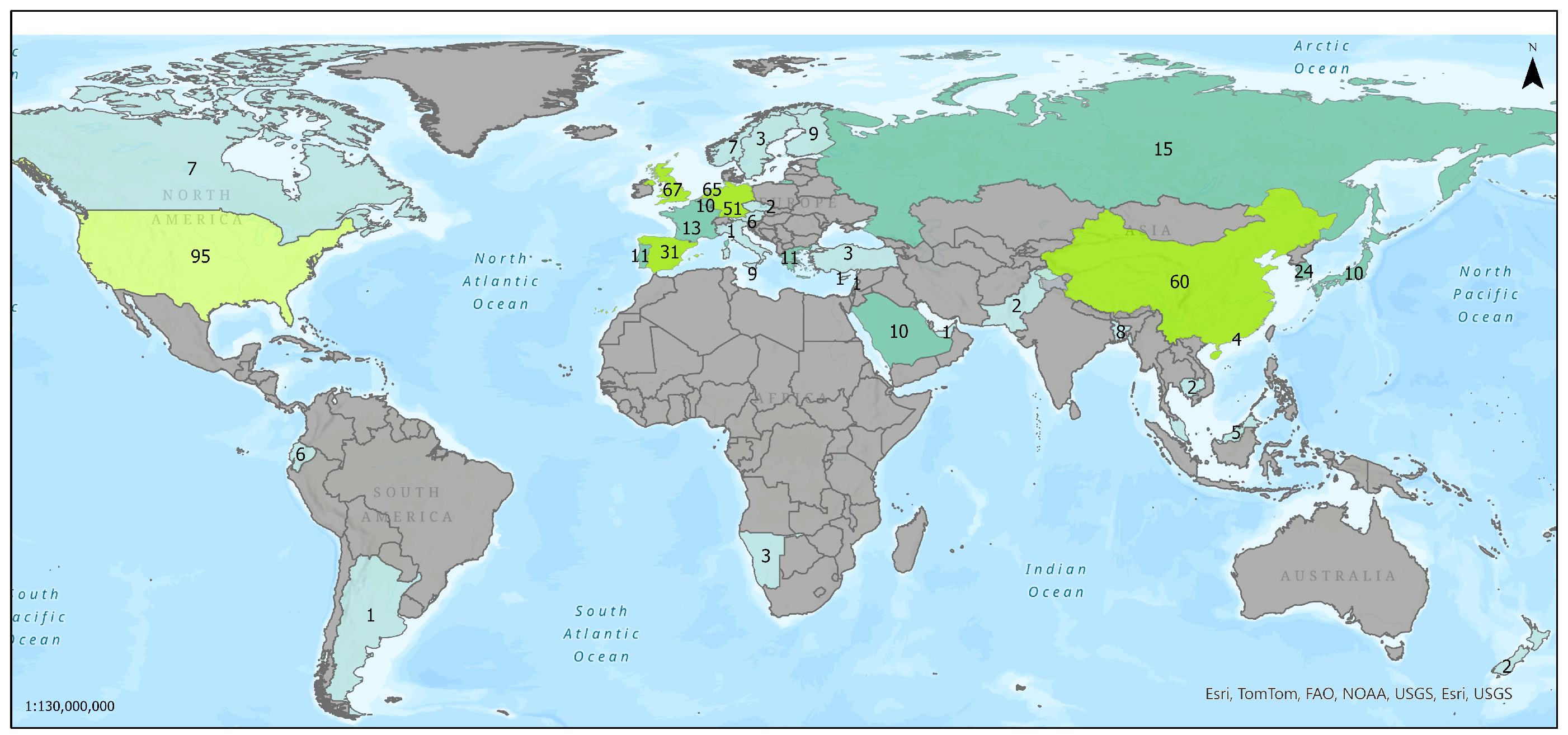
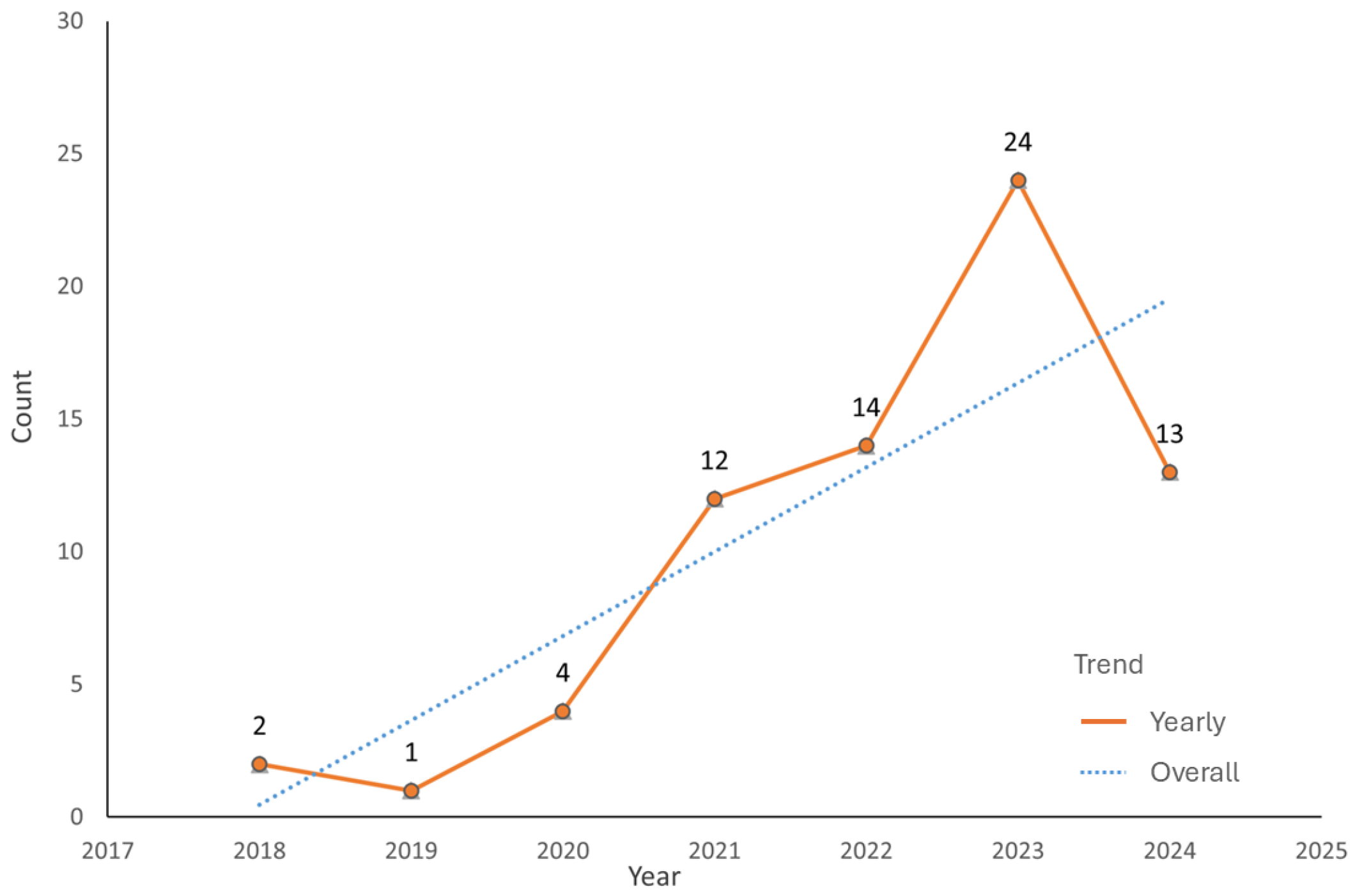
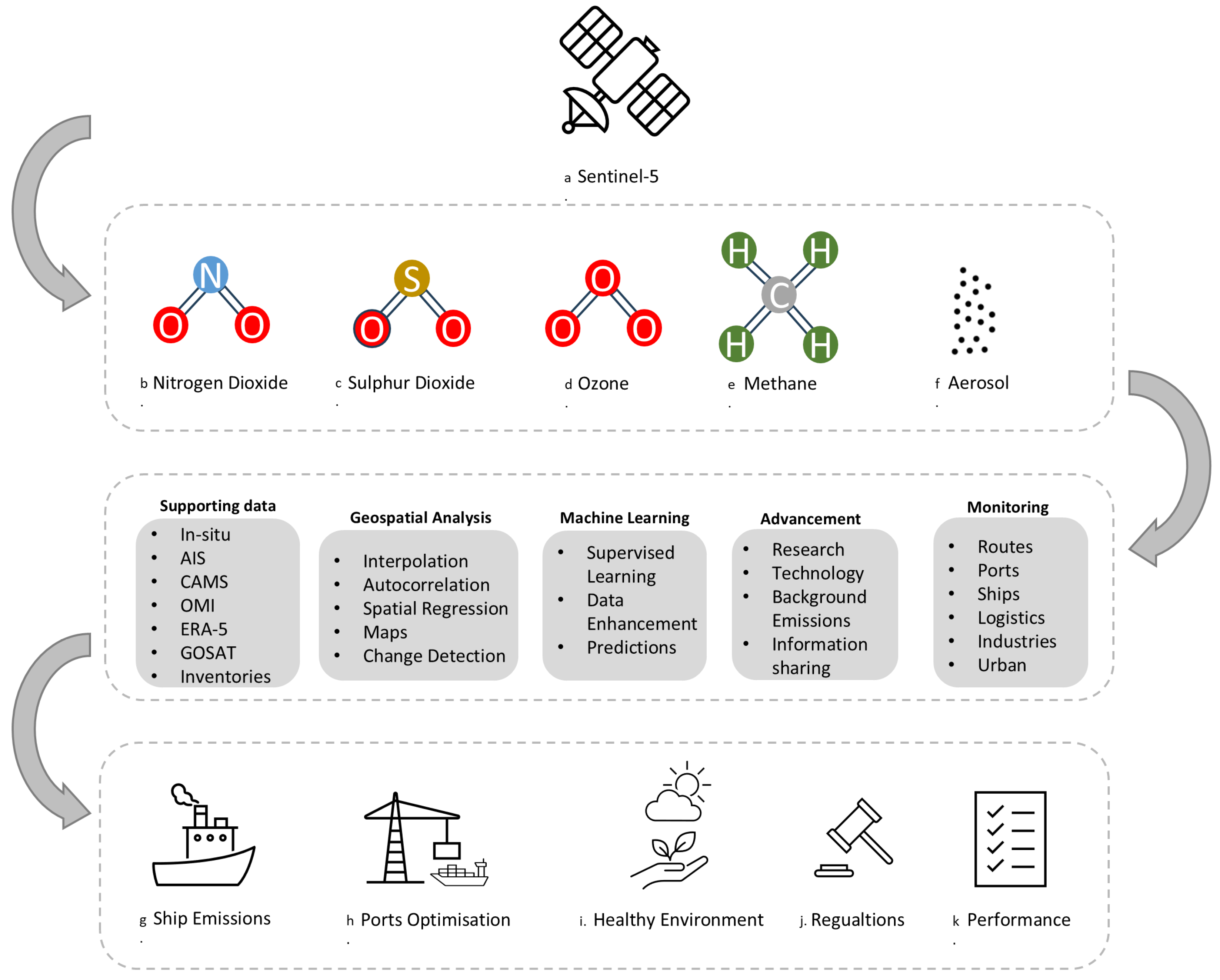
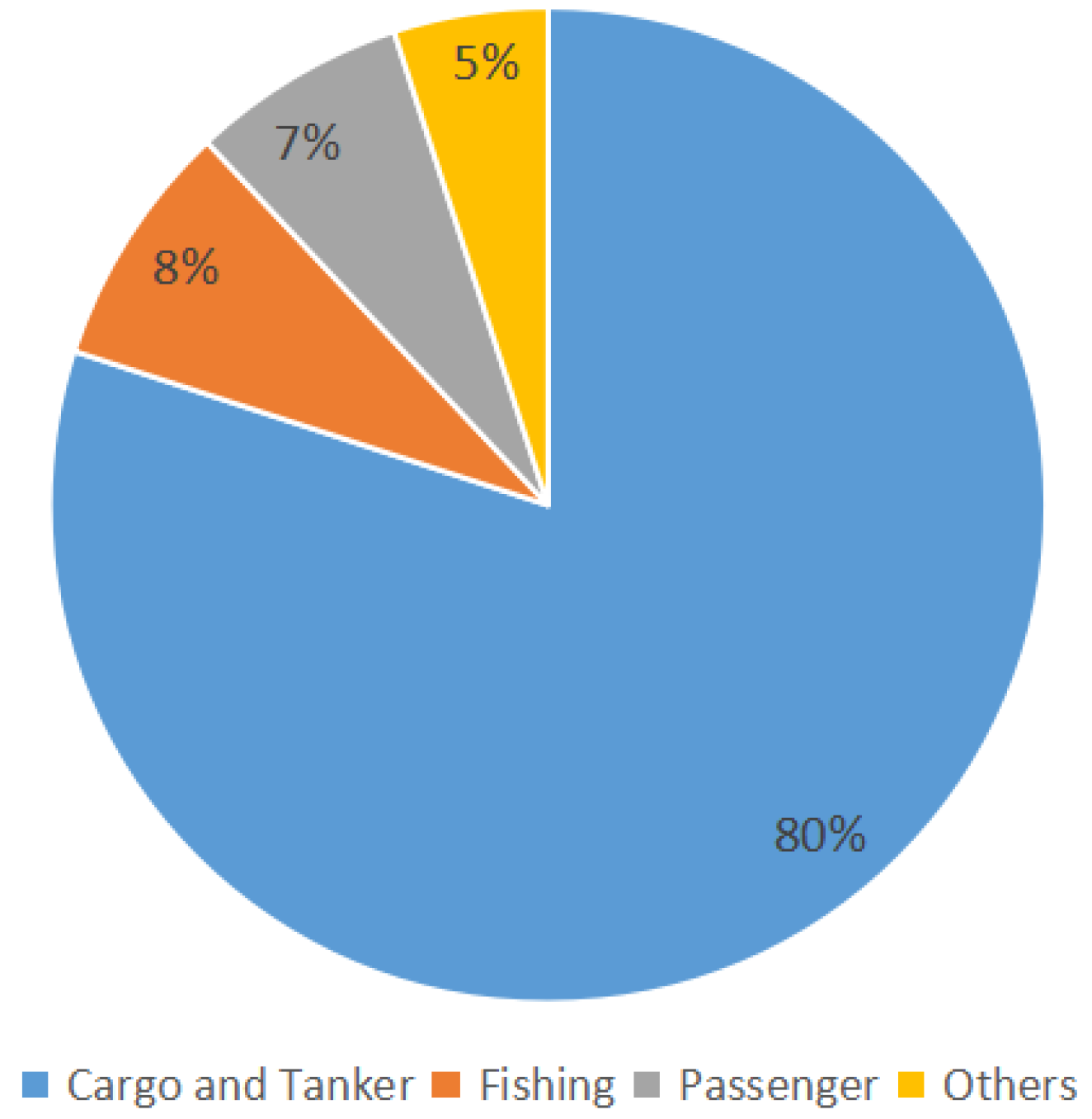
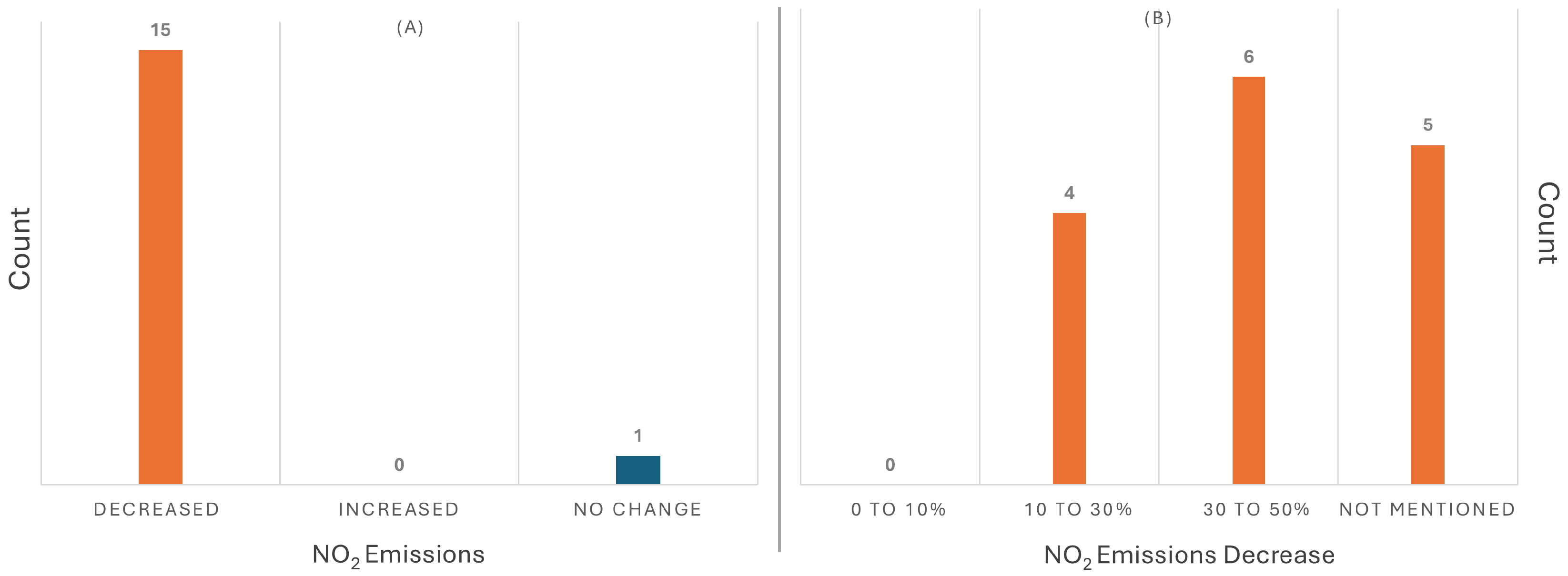
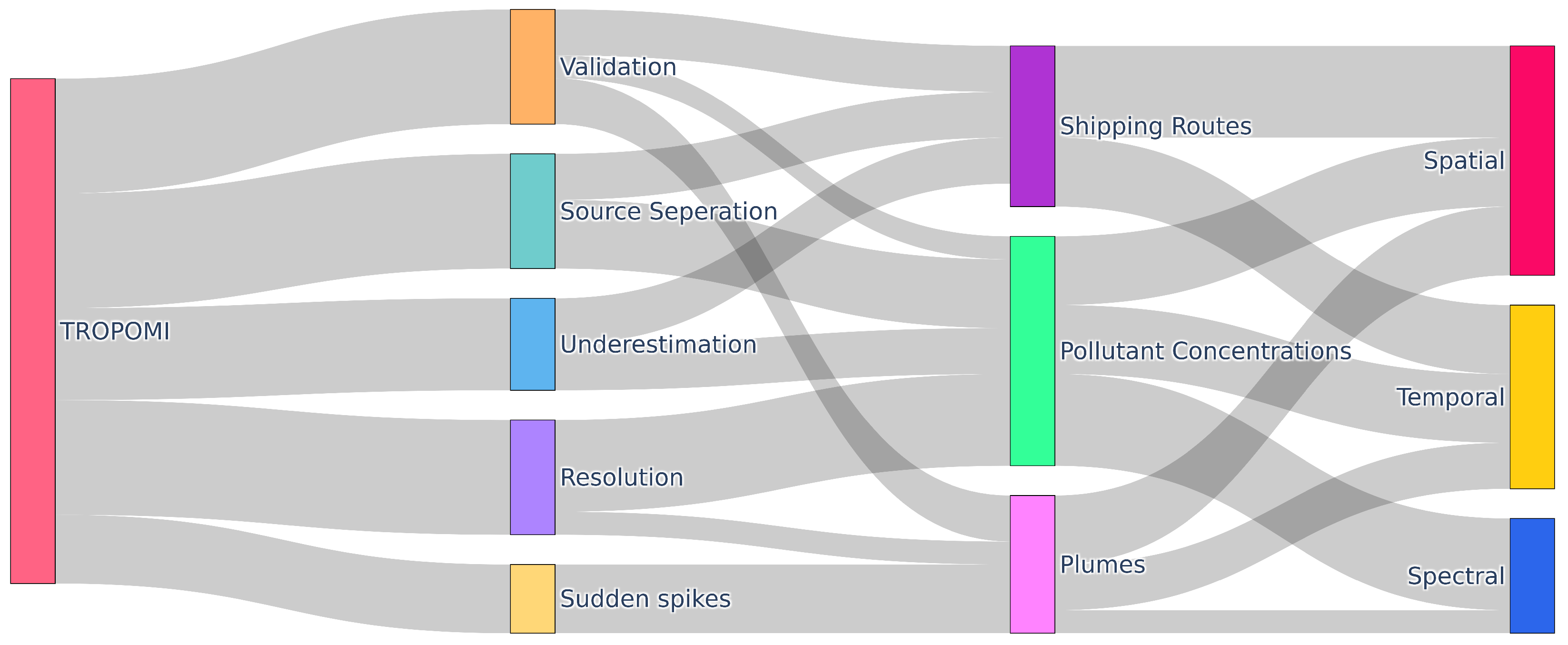
| Screening | Web of Science | Scopus |
|---|---|---|
| S1 | ((“sentinel 1”) AND (“cams” OR “copernicus atmosphere monitoring service” OR “emission“ OR “pollution” OR “plume*” OR “greenhouse*”)) AND ((“ship*” OR “vessel*” OR “maritime*” OR “ais” OR “port*”) AND (“detect*” OR “air*” OR “monitor*” OR “fuel*” OR “transit*” OR “optimizat*” OR “anthropogenic” OR “concentrat*” OR “machine learning” OR “artificial*”)) | ((“sentinel 1”) AND (“cams” OR “copernicus atmosphere monitoring service” OR “emission” OR “pollution” OR “plume*” OR “greenhouse*”)) AND ((“ship*” OR “vessel*” OR “maritime*” OR “ais” OR “port*”) AND (“detect*” OR “air*” OR “monitor*” OR “fuel*” OR “transit*” OR “optimizat*” OR “anthropogenic” OR “concentrat*” OR “machine learning” OR “artificial*”)) |
| S2 | ((“sentinel 2”) AND (“cams” OR “copernicus atmosphere monitoring service” OR “emission” OR “pollution” OR “plume*” OR “greenhouse*”)) AND ((“ship*” OR “vessel*” OR “maritime*” OR “ais” OR “port*”) AND (“detect*” OR “air*” OR “monitor*” OR “fuel*” OR “transit*” OR “optimizat*” OR “anthropogenic” OR “concentrat*” OR “machine learning” OR “artificial*”)) | ((“sentinel 2”) AND (“cams” OR “copernicus atmosphere monitoring service” OR “emission” OR “pollution” OR “plume*” OR “greenhouse*”)) AND ((“ship*” OR “vessel*” OR “maritime*” OR “ais” OR “port*”) AND (“detect*” OR “air*” OR “monitor*” OR “fuel*” OR “transit*” OR “optimizat*” OR “anthropogenic” OR “concentrat*” OR “machine learning” OR “artificial*”)) |
| S5 | ((“sentinel 5” OR “tropomi” OR “s5p”) AND (“cams” OR “copernicus atmosphere monitoring service” OR “emission” OR “pollution” OR “plume*” OR “greenhouse*”)) AND ((“ship*” OR “vessel*” OR “maritime*” OR “ais” OR “port*”) AND (“detect*” OR “air*” OR “monitor*” OR “fuel*” OR “transit*” OR “optimizat*” OR “anthropogenic” OR “concentrat*” OR “machine learning” OR “artificial*”)) | ((“sentinel 5” OR “tropomi” OR “s5p”) AND (“cams” OR “copernicus atmosphere monitoring service” OR “emission” OR “pollution” OR “plume*” OR “greenhouse*”)) AND ((“ship*” OR “vessel*” OR “maritime*” OR “ais” OR “port*”) AND (“detect*” OR “air*” OR “monitor*” OR “fuel*” OR “transit*” OR “optimizat*” OR “anthropogenic” OR “concentrat*” OR “machine learning” OR “artificial*”)) |
| Search | TITLE-ABS-KEY | TITLE-ABS-KEY |
| Language | English | English |
| Document Types | Articles and reviews | Articles and reviews |
| Research Areas | Maritime, Copernicus Sentinel, air pollution | Maritime, Copernicus Sentinel, air pollution |
| Journal | Articles per Journal |
|---|---|
| Atmospheric Chemistry and Physics | 9 |
| Remote Sensing | 6 |
| Atmospheric Measurement Techniques | 5 |
| Science of the Total Environment | 4 |
| Remote Sensing of Environment | 3 |
| Atmospheric Environment | 3 |
| Atmosphere | 3 |
| Environmental Research | 2 |
| Environmental Pollution | 2 |
| Environmental Research Letters | 2 |
| Sustainability | 2 |
| Institute | Count |
|---|---|
| National Aeronautics and Space Administration, United States | 11 |
| Karlsruhe Institute of Technology, Germany | 7 |
| Royal Belgian Institute for Space Aeronomy, Belgium | 7 |
| Wageningen University, Netherlands | 5 |
| Heidelberg University, Germany | 5 |
| National Institute for Environmental Studies, Japan | 5 |
| Wuhan University, China | 5 |
| King Fahd University of Petroleum & Minerals, Saudi Arabia | 5 |
| University of Leeds, United Kingdom | 5 |
| University of Maryland, United States | 5 |
| University of California, United States | 5 |
| Sr. | Subject | Data Used | Pollutant Analysed | Suggested Articles |
|---|---|---|---|---|
| a. | Ship plume detection | S-5P, CAMS, model (LOTOS-EUROS), in situ (AIS, EEA) | [8,20,48,49,59] | |
| b. | Shipping routes and hotspots | S-5P, S-1, EMI GaoFen-5B, ERA5, CAMS, model (EMODnet, LOTOS-EUROS), in situ (AIS, ship track count, global container throughput index) | [9,48,54,56,58,60,62] | |
| c. | Ablation and sensitivity analysis | S-5P | [49,69] | |
| d. | Event-based studies | S-5P, OMI, ERA-5, in situ (El Arenosillo, Vaisala 520 WXT, Teledyne 200E) | [52,68] | |
| e. | Compliance monitoring | S-5P, CAMS, TM5, model (LOTOS-EUROS DESCO, NEC, LRTAP, E-PRTR), in situ (AIS, EEA) | [48,61,64] | |
| f. | Comparison and validation | S-5P, TEMPO, MODIS AOD, OMI, ERA-5, SCIAMACHY Envisat, model (HYSPLIT, EMG, HRRR, GCAS), GeoTASO (aircraft-based), in situ (CAPS, Pandora, sonde, Thermo Fisher Scientific 49i UV photometer, Picarro G-1301m, COCOON) | , , , , aerosol, , , VOC | [51,52,55,63,65,66,67,70,71] |
| g. | Change detection | S-5P, CAMS, ERA5, ERA-interim, MODIS, GOME-2, MERRA-2, S-2, CLMS LULC, HBASE Landsat, model (GEOS-CHEM, GAM, CMAQ CTM, HYSPLIT), in situ (EEA, AIRBASE, AQ eReporting, HERMESv3, CARB, PeMS, NOAA, aethalometer AE33) | , , , , , , VOC | [50,52,53,57,62,69,72,73,74,75,76,77,78,79] |
| Paper | Data Available | Code Available |
|---|---|---|
| [8] | Yes | No |
| [9] | Yes | No |
| [20] | Yes | No |
| [48] | Yes | No |
| [49] | Yes | Yes |
| [50] | No (upon request) | No |
| [51] | No | No |
| [52] | No (upon request) | No |
| [53] | Yes | No |
| [54] | No | No |
| [55] | Yes | No |
| [56] | No (upon request) | No |
| [57] | Yes | No |
| [58] | No (upon request) | No |
| [59] | Yes | Yes |
| [60] | No (upon request) | No |
| [61] | Yes | No |
| [62] | Yes | Yes |
| [63] | Yes | No |
| [64] | Yes | No |
| [65] | Yes | No |
| [66] | Yes | Yes |
| [67] | Yes | No |
| [68] | Yes | No |
| [69] | No (upon request) | No |
| [48] | Yes | No |
| [72] | Yes | Yes |
| [70] | Yes | No |
| [73] | Yes | No |
| [74] | Yes | No |
| [75] | Yes | No |
| [76] | Yes | No |
| [77] | No | No |
| [78] | Yes | No |
| [71] | Yes | Yes |
| [79] | No | No |
| Sensor | Spatial Resolution | Reference |
|---|---|---|
| TEMPO | 2 km × 4.5 km | [102] |
| TROPOMI (after 6 August 2019) | 3.5 km × 5.5 km | [103] |
| TROPOMI (before 6 August 2019) | 3.5 km × 7 km | [104] |
| GEMS | 3.5 km × 8 km | [105] |
| OMI | 13 km × 24 km | [106] |
| EMI GaoFen-5B | 13 km × 48 km | [103] |
| MOPITT | 22 km × 22 km | [107] |
| GOME-2 (after July 2013) | 40 km × 40 km | [108] |
| SCIAMACHY | 30 km × 60 km | [106] |
| OMPS | 50 km × 50 km | [107] |
| GOME-2 (before July 2013) | 40 km × 80 km | [108] |
| MAESTRO SCISAT-1 | 200 km × 200 km | [109] |
Disclaimer/Publisher’s Note: The statements, opinions and data contained in all publications are solely those of the individual author(s) and contributor(s) and not of MDPI and/or the editor(s). MDPI and/or the editor(s) disclaim responsibility for any injury to people or property resulting from any ideas, methods, instructions or products referred to in the content. |
© 2025 by the authors. Licensee MDPI, Basel, Switzerland. This article is an open access article distributed under the terms and conditions of the Creative Commons Attribution (CC BY) license (https://creativecommons.org/licenses/by/4.0/).
Share and Cite
Batista, T.; Jamal, S.A.; Isbaex, C. Sentinel Data for Monitoring of Pollutant Emissions by Maritime Transport—A Literature Review. Remote Sens. 2025, 17, 2202. https://doi.org/10.3390/rs17132202
Batista T, Jamal SA, Isbaex C. Sentinel Data for Monitoring of Pollutant Emissions by Maritime Transport—A Literature Review. Remote Sensing. 2025; 17(13):2202. https://doi.org/10.3390/rs17132202
Chicago/Turabian StyleBatista, Teresa, Saad Ahmed Jamal, and Crismeire Isbaex. 2025. "Sentinel Data for Monitoring of Pollutant Emissions by Maritime Transport—A Literature Review" Remote Sensing 17, no. 13: 2202. https://doi.org/10.3390/rs17132202
APA StyleBatista, T., Jamal, S. A., & Isbaex, C. (2025). Sentinel Data for Monitoring of Pollutant Emissions by Maritime Transport—A Literature Review. Remote Sensing, 17(13), 2202. https://doi.org/10.3390/rs17132202










